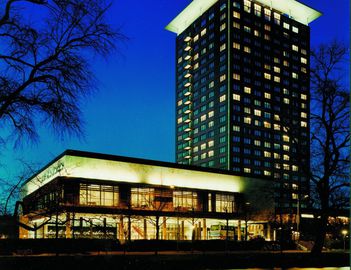

The hotel was built near the RAI Congress Center, Amsterdam’s main exhibition venue, in 1962 and belongs to the eponymous hotel chain based in Japan. As their objective, the hotel directors have stated they strive to become the world’s best hotel chain. That inspired the philosophy of ‘the best ACS’ – best accommodation, best cuisine and best serice. In regard to the best accommodation or the facilities of the hotel, the architect Aoki tackled the problem of reacting to rapid advancements in the hotel business by constructing facilities that were supposed to “age gracefully”. Daily maintenance and service have thus become of utmost importance, as was the necessity and the ability to quickly update the new equipment and the latest systems. The ‘best cuisine’ standard is met by consistently high-quality food. The 2-Michelin star hotel restaurants testify to the accomplishment of this goal. Its top floor bar offers breathtaking views of the Amsterdam Zuid district as well a great panorama of the whole city. And the third goal was attained by introducing impeccable service unrivalled by any other hotel in Amsterdam at the time.
Seventy-five meters high, the roof of the Okura Hotel doubles as the biggest barometer in the Netherlands. The color of the lighting, clearly visible by night, indicates the weather forecast for the following day. If the roof is lighted blue, the next day promises to be sunny. Green lighting means poor weather and white – cloudy.
In front of the hotel, along the canal, you can hire electric or solar-powered boats for tours around the canals. It’s a worthwhile ride, and there’s no need for a license to navigate in these low-speed vessels. Just bring your passport and credit card.
The Hotel Okura stands on the Amstelkanaal. It was dug late in the 19th century, during the Amsterdam expansion to the south, as part the so-called Plan Zuid by the notedcityarchitectBerlage. The hotel is on theJozefIsraëlskade embankment, so named after the 19th century Dutch painter, while the opposite quay bears the name Amstelkade.
The bridge to the west of Hotel Okura was designed by Piet Kramer, who also designed the Coöperatiehof and the Dageraadcomplex, in 1927. The sculptures are by HildoKrop, who worked in tandem with Kramer as the city sculptor. The bridge is a striking example of the Amsterdam School. It has four turrets going down to the canal water level. The turrets house businesses, including a pizzeria with a ‘sail through’ window where boatmencan pick their order up without leaving the boat.
The sculptures adorning the bridge represent a faun submerged up to itschin in rippling water so that only his head is visible, a coiled snake surrounded by ripples in the water, another head swimming in the waves and a fish. Such symbolism, even though the precise meaning remains obscure, was typical of the Amsterdam School style. In 2004 this bridge was declared a state monument and, in 2011, a neighborhood initiative proposed naming this bridge after the Amsterdam School.